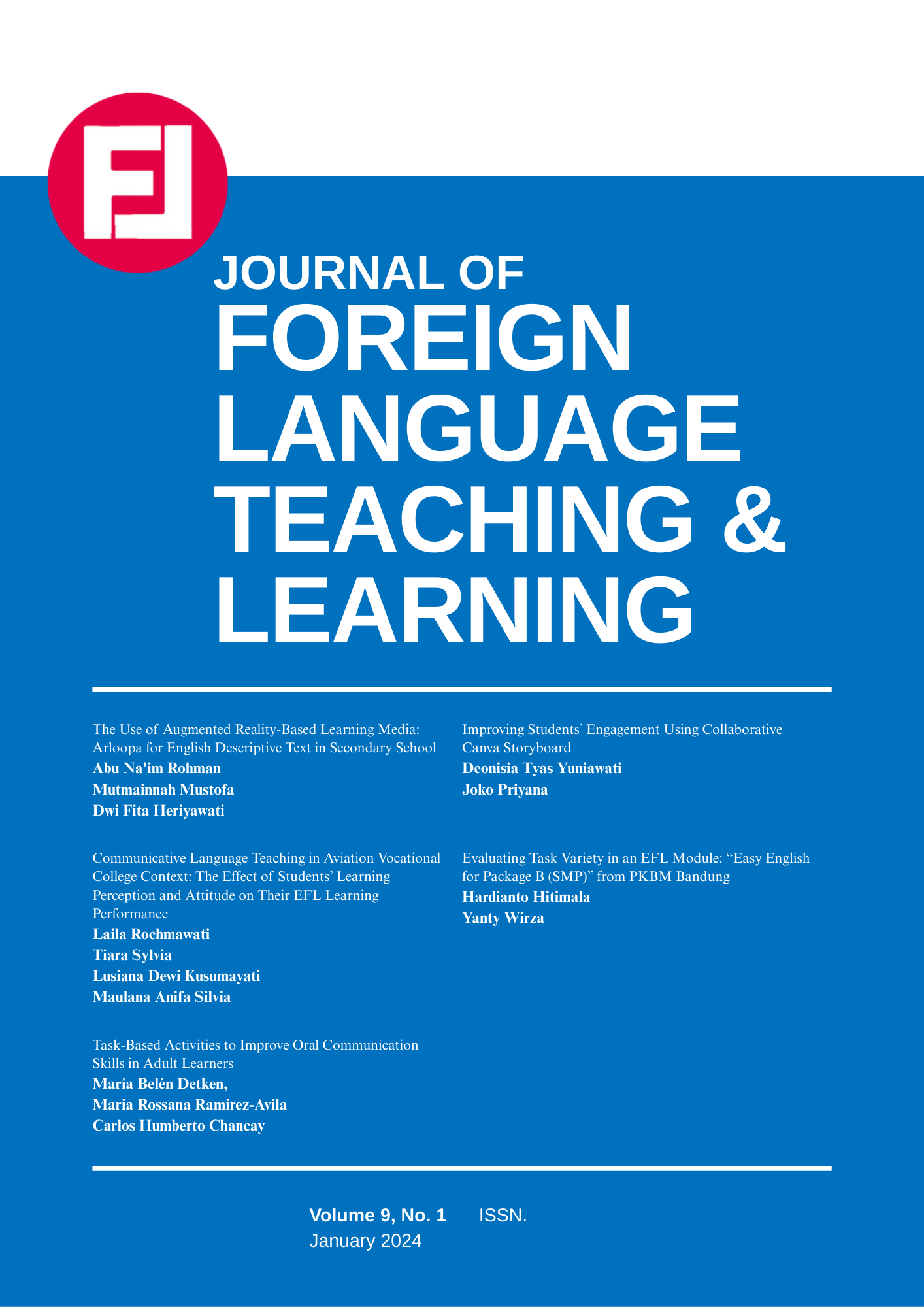Evaluating Task Variety in an EFL Module: “Easy English for Package B (SMP)” from PKBM Bandung
DOI:
https://doi.org/10.18196/ftl.v9i1.20910Keywords:
EFL Students, Textbook, Module, Task VarietyAbstract
English Textbook is a widely used source for teaching English in Indonesia, but studies showed that many textbook tasks are unsuitable for students’ needs. Therefore, the objective of this study was to find out the task types presented in the EFL Textbook, Easy English for Package B (Junior High School level), used by an Institution, focused on Module 1, Getting Acquaintance. The research design was a content analysis under a descriptive qualitative study. The data were collected from the EFL Module 1, and 1 teacher was recruited as a participant. The study used the task types rubric by Nunan (1999; 2004). Besides the content analysis, an interview was conducted to identify tasks found in the textbook and the teacher's perspective regarding the module. The finding showed that the module does not meet the standards of a good textbook, predominantly because it centered around linguistic tasks, comprising 97.66% of all tasks; another type of task is creative tasks, constituting only 2.32%. In other words, the module lacks diversity in task types, as there are no cognitive, interpersonal, or affective tasks. In the interview, the teacher shows a negative attitude towards the tasks in module 1, which is that the tasks ignore many other important aspects of learning. To improve, textbook makers should include various tasks from Nunan’s framework that apply to real life. Teachers should use these materials creatively, and schools should offer textbooks that provide comprehensive language tasks.
References
Abulela, M. A. A., & Harwell, M. M. (2020). Data analysis: Strengthening inferences in quantitative education studies conducted by novice researchers. Educational Sciences: Theory and Practice, 20(1), 59–78. http://dx.doi.org/10.12738/jestp.2020.1.005
Alemi, M., Ensafi, A., & Rezanejad, A. (2021). Global business textbook evaluation: Task types in the spotlight. IARTEM E-Journal, 13(1), 1-20. https://doi.org/10.21344/iartem.v13i1.826
Alemi, M. & Hesami, Z. (2014). The presentation of different types of tasks in ELT textbooks. Teaching English Language, 8(1): 61–92. http://www.teljournal.org/article_54565_e38b236c722820fd404b4787a203e71d.
Ansary, H., & Babaii, E. (2002). Universal characteristics of EFL ESL: a step towards systematic textbook evaluation. The Internet TESL Journal. http://iteslj.org/Articles/Ansary-Textbooks/
Asgarikia (2014). The effects of task type, strategic planning, and no planning on written performance of Iranian intermediate EFL learners. Procedia - Social and Behavioral Sciences, 98, 276-285. https://doi.org/10.1016/j.sbspro.2014.03.417
Ayu, M., & Inderawati, R. (2018). EFL textbook evaluation: The analysis of tasks presented in English textbook. Teknosastik, 16(1), 21-25. https://ejurnal.teknokrat.ac.id/index.php/teknosastik/article/view/87
Behnke, Y. (2018). Textbook effects and efficacy. In E Fuchs & A Bock (Eds.), The Palgrave Handbook of Textbook Studies (pp. 383–398). Palgrave Macmillan, New York. https://doi.org/10.1057/978-1-137-53142-1_28
Bogdan, R. C & Biklen, S. K. (2003). Qualitative Research for Education: An Introduction to Theories and. Methods (4th ed.). New York: Pearson Education Group.
Braun, V., & Clarke, V. (2006). Using thematic analysis in psychology. Qualitative Research in Psychology, 3(2), 77–101. https://doi.org/10.1191/1478088706qp063oa
Brown, H. D. (1994). Teaching by principles: An interactive approach to pedagogy. NJ: Prentice Hall
Bygate, M. (2020). Some directions for the possible survival of TBLT as a real-world project. Language Teaching, 53(3), 275–288. http://dx.doi.org/10.1017/S0261444820000014
Canale (2021). The language textbook: representation, interaction, and learning. Language, Culture and Curriculum, 34 (2), 113–118, https://doi.org/10.1080/07908318.2020.1797080
Creswell, J. W., & Creswell, J. D. (2018). Research design: qualitative, quantitative, and mixed methods approach. SAGE Publications.
Creswell, J. W. (2012). Educational research: planning, conducting, and evaluating: quantitative and qualitative research (4th ed.). Pearson
Cunningsworth, A. (1995). Choosing Your Coursebook. Macmillan Heinemann.
Elmiana, D.S. (2018). A critical analysis of tasks in senior high school EFL textbooks in Indonesia. Journal of Asia TEFL, 15(2): 462–70. http://dx.doi.org/10.18823/asiatefl.2018.15.2.14.462
Ellis, R. (2003). Task-based language teaching and learning. Oxford University Press
Harbi (2017). Evaluation study for secondary stage EFL textbook: EFL teachers’ perspectives. English Language Teaching; 10 (3), 26-39. http://dx.doi.org/10.5539/elt.v10n3p26
Harmer, J. (2007). How to teach English. Longman Inc.
Harvey, L. (2015). Beyond member-checking: A dialogic approach to the research interview. International Journal of Research & Method in Education, 38(1), 23–38. https://doi.org/10.1080/1743727X.2014.914487
Hashemnezhad, H. (2015). Qualitative content analysis research: A review article. Journal of ELT and Applied Linguistics (JELTAL), 3(1), 54–62.
Huda. N. & Syafei, A. F. R., (2020). Task types found in the textbooks "Bahasa Inggris: When English Rings a Bell" and Bright, an English course for junior high school. Journal of English Language Teaching. 9(1): 23–31. https://doi.org/10.24036/jelt.v9i1.107932
Hutchinson, T., & Torres, E. (1994). The textbook as agent of change. ELT Journal, 48, 315-328. https://doi.org/10.1093/elt/48.4.315
Inayah. Y. N, Gunarto, S. P., & Sundari, H. (2022). The analysis of tasks in English textbook for junior high school: a case of when English rings a bell for 7th grade. Proceedings of the National Seminar on Language, Arts, and Literature “Language, Art, Literature and Its Teaching in the Digital Age”. Vol 1. 92–99. https://www.proceeding.unindra.ac.id/index.php/sinastra/article/view/6067/1639
Li, F., Wang, L. (2024). A study on textbook use and its effects on students’ academic performance. Discip Interdscip Sci Educ Res, 6(4), 1-20. https://doi.org/10.1186/s43031-023-00094-1
Littlejohn, A. (2011). The analysis of language teaching materials: Inside the Trojan Horse. In B. Tomlinson (Ed.), Materials Development in Language Teaching (pp. 179-211). Cambridge University Press. https://doi.org/10.1017/9781139042789.011
Mustofa, M. I., & Wirza, Y. (2023). Promoting learner autonomy through EFL textbook: the textbook facilitation and the students’ and teacher’s perceptions. Journal on English as a Foreign Language, 13(1), 289-313. https://doi.org/10.23971/jefl.v13i1.6056
Nicmanis, M. (2024). Reflexive Content Analysis: An approach to qualitative data analysis, reduction, and description. International Journal of Qualitative Methods, 23, 1–12. https://doi.org/10.1177/16094069241236603
Novianti, P., & Ambarwati, E.K. (2023). A textbook analysis of "My Next Words" for the fifth-grade elementary school. Jo-ELT (Journal of English Language Teaching), 10(1), 12-25. https://doi.org/10.33394/jo-elt.v10i1.6972
Nunan, D. (2006). Task-based language teaching in the Asia context: Defining 'task .'Asian EFL Journal Press. https://www.asian-efl-journal.com/September_2006_EBook_editions.pdf
Nunan, D. (2004). Task-based language teaching. Cambridge University Press
Nunan, D. (1999). Second language teaching and learning. Heinle/Thomson.
Nunan, D. (1989). Designing tasks for the communicative classroom. Cambridge University Press.
Opoku-Amankwa, K., Brew-Hammond, A., & Kofigah, F. (2011). What is in a textbook? Investigating the language and literacy learning principles of the ‘Gateway to English’ textbook series. Pedagogy, Culture & Society, 19(2), 291-310. https://doi.org/10.1080/14681366.2011.582264
Richards, J. (2002). Approaches and methods in language teaching. Cambridge University Press.
Gholampour, S., & Mehrabi, D. (2023). Literature Review of ELT Textbook Evaluation. Mextesol Journal, 47(2), 1-7. https://www.mextesol.net/journal/index.php?page=journal&id_article=46436
Scane, J., Guy, A. M., & Wenstrom, L. (1991). Think, write, share: Process writing for adult ESL and basic education students. OISE Press.
Seddighi, H., Yousefzadeh, S., & López, M. (2021). Qualitative content analysis as a research method to investigate hazards information in school textbooks. MethodsX, 8, 101559. https://doi.org/10.1016/j.mex.2021.101559
Tambunan (2019). Content analysis of English textbook "Interactive English" used in first-grade junior high school in 2013 curriculum. Journal of English Teaching & Applied Linguistics, 1 (1). 20-27. https://doi.org/10.36655/jetal.v1i1.101
Tomaszewski, L. E., Zarestky, J., & Gonzalez, E. (2020). Planning Qualitative Research: Design and Decision Making for New Researchers. International Journal of Qualitative Methods, 19, 1-7. https://doi.org/10.1177/1609406920967174
Ulum, Ö. G. (2016). A descriptive content analysis of the extent of Bloom's taxonomy in the reading comprehension questions of the course book q: Skills for Success 4 reading and writing. The Qualitative Report, 21(9), 1674–1683. https://doi.org/10.46743/2160-3715/2016.2172
Downloads
Published
How to Cite
Issue
Section
License
Copyright
Authors retain copyright and grant the journal right of first publication with the work simultaneously licensed under a Creative Commons Attribution-ShareAlike 4.0 International License that allows others to share the work with an acknowledgment of initial publication in this journal.
Authors are permitted and encouraged to post their work online (e.g., in institutional repositories, social media account, or on their website) after the article getting published in the journal, as it can lead to productive exchanges and earlier and greater citation of published work (See The Effect of Open Access).License
You are free to:
- Share — copy and redistribute the material in any medium or format
- Adapt — remix, transform, and build upon the material for any purpose, even commercially.
Attribution — You must give appropriate credit, provide a link to the license, and indicate if changes were made. You may do so in any reasonable manner, but not in any way that suggests the licensor endorses you or your use.
ShareAlike — If you remix, transform, or build upon the material, you must distribute your contributions under the same license as the original.
- No additional restrictions — You may not apply legal terms or technological measures that legally restrict others from doing anything the license permits.



.png)





